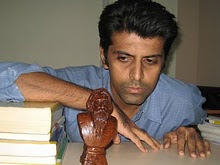This and That
Games Over?
The other day, while reading a childrens' book on the origins of our popular games - football, basketball, volleyball, handball... - I was struck by a simple fact: most if not all of these games were conceived and their essential form finalized by 1900. Thereafter (at least in the last 50 years), no fundamentally new global game seems to have emerged (some local games or recast versions of already existing games - kabaddi or rugby or volleyball in its saucy beach version or maybe even cricket in its T20 avatar - might be going global in a big way but that does not change the basic picture).
Perhaps, there aren't any more games left - there may only be so many possible physical games that Homo Sapiens can actually play. If indeed, the number of games is so limited, those games already with us are discoveries and not inventions.
The Median Might be the Message:
Statistical data analysis prefers the median over the arithmetic mean when the frequency distribution of the data is skewed. The mean can get dragged far from a typical value by skewed data and can lose the ability to provide the best central location for the data; the median resists such drag much better. Moreover, outliers which can severely affect the arithmetic mean barely touch the median (eg: if Ambani builds his home in a slum, he can elevate the Arithmetic mean of the incomes in the neighborhood to the level of the richest countries but the median income would pretty much stay where it was - and continue to present an honest picture of the neighborhood).
I know very little economics. Every popular analysis of the Indian economy that I have seen is based on arithmetic means - average income, average GDP and so on. One suspects, if instead of the mean per capita income, the median income is considered (I tend to believe that India has one of the most skewed income distributions in the world with some spectacular outliers), many of the conclusions - and plans - might get fundamentally altered.
Chakka - here and there:
Long ago, I wrote a post lamenting how the chakka (jackfruit), despite its abundant nutritive value and culinary potential, has fallen out of favor among Keralites. Things have improved somewhat - chakka has been selected as our National Fruit and chakka-fests have greatly increased in frequency as well as visibility. However, despite all that, a huge fraction of our abundant chakka crop goes waste, unplucked. Yesterday, I saw this massive cluster rotting away in the monsoon showers, just a few feet above the ground.

But our neighbors have continued to show great sensitivity to the charms of this fruit. A wayside scene from Mysore:

Hasta and Hasti
The word Hasta means "hand" in Sanskrit. Hasti means "the one with a hand" and implies the elephant - the hand referred to being of course, its trunk. But the hasta-hasti connection appears to go even farther...
Here is a hasta, painted onto a wallet:

Turn it upside down and it becomes a hasti:

Tribute to Tintoretto:
During one of his typically incandescent expository performances, hefty, bearded and orange garbed Mathematician Mahan Maharaj strikes a dramatically 'manneristic' pose that brings to mind St Mark's miraculous stunts as envisioned by Venetian Master Tintoretto:


The Birth of a Nation:
"Mohammad Ali Jinnah rose to be the undisputed leader of the Indian Muslim League. He developed and gave a clear formulation to the original idea for a Nation put forward by Dr. Iqbal with the name 'Pakistan'. At a meeting held in Lahore in 1940, Jinnsh declared the attainment of Pakistan as the main goal of the League. The British Government accepted his proposal. As per the Indian Independence Act, India was partitioned and the sovereign state of Pakistan came into being as a member of the British Commonwealth on the 14th of August 1947 with Jinnah Sahib as its supreme leader. Those were troubled times as untoward incidents and massacres took place in India and Pakistan. Soon thereafter, the people of Punch in western Kashmir rose against Pakistan. The latter responded by deploying its army and a dangerous situation developed. However, thanks to an intervention by the UN, war was averted. Jinnah Sahib died in September 1948...."
That was a succinct passage from a textbook of Islamic History published by the Government of Kerala via the 'Bhasha Institute' - my translation.
Pazhoor Now
At Pazhoor, the Muvattupuzha river is in spate The island has mostly gone under. The banks have received a generous dumping of plastics and more rafts of it drift by...:

Representations:
A joke of sorts has been going around: "Don't lament the continued failure of African teams at the World Cup. France is still there and may even win it!"
But the Brits are a step ahead. BBC put up this graphic in its analysis of the England-Croatia match:





















